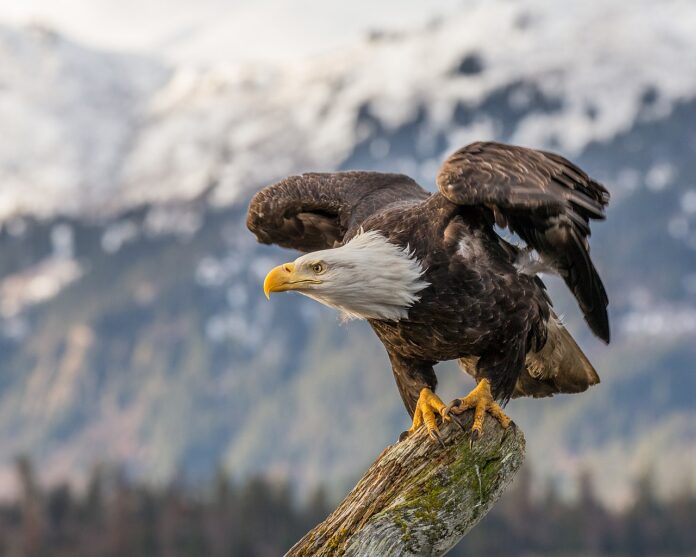
BY HARRY WEEKES
Bald eagle.
It’s one of those birds so iconic the mere mention of its name brings a certain reverie.
You’ve heard other names in these pages, most recently ferruginous hawk, hooded merganser, Northern saw-whet owl. Exotic names, beautiful birds, each a unique feathered beast uncommonly seen. I am willing to bet that if we were walking together and I pointed and said one of those three names, you would look over, squint to see what I was looking at, and maybe ask one or two questions, one of which would be, “Is that unusual?”
Now, if I just leaned a little forward in the car and looked toward the sky and said, “bald eagle,” I bet you’d stop what you’re doing, crane your head and neck, and then hit me with a slew of questions that would start with “Where?”, proceed to “Are you sure?”, and then continue with working to show the rest of the people in the car the bird—“There, there! Do you see it!?”
You would also make some sort of comment about America, patriotism, and the grandeur of Nature. That’s Nature with the capital N.
Of course, the ‘you’ in the above scenarios is any one of my family members. Perhaps, though, it might be you… you.
There is something about bald eagles that draws us in. Maybe it is as simple as the fact that they are our national symbol (which, in case it was not obvious, is a bird; how cool is that?).
A brief tangent. In cases like this, where I start thinking about choosing a symbol to represent a country (tangent within a tangent—Ben Franklin wanted the national bird to be the turkey, in so many ways a better choice, except when the Founding Fathers pretended they were at a sporting event and started yelling, “Go Eagles!” and “Go Turkeys!” … you know the path history chose), I invariably think, “What bird would represent me?”
My penchant for grouse, flickers, and chickadees leaves me wondering. I do think it would be cool to embody the sage grouse as a family and once a year all gather in some strange place to dance.
Back to bald eagles.
They were a good choice because they are so impressive. First, they’re huge—at almost 3 feet long with nearly a 7-foot wingspan, and coming in at 10 pounds, they’re like a flying, feathered tiger. Then add the obvious, the heads and tails of the adults are white, making the answer to “Are you sure?” obvious even to a total novice.
Yeah, I’m sure.
And the particular beauty of baldies around here? They are just rare enough. The ones you see driving up north. The one that cruises the river corridor by the Bow Bridge. The one that perches along Buttercup Road in the cottonwoods. Some of these might be the same bird. It might be two. It might be more. Regardless, we see them just intermittently enough not to know and to still be wowed.
The one my students and I saw flying out of Alturas Lake when we were there at the end of February for our Winter Ecology Field Study? That one cutting across the deep green pines, cutting through the falling flakes of snow? The one that came when I was asking, “How do you think animals adapt to winter up here?” “How do you think that animal adapts?”
There was no need to answer, mostly because we all just stood there, silently, watching it fly by. Just what you should do.
Harry Weekes is the founder and head of school at The Sage School in Hailey. This is his 52nd year in the Wood River Valley, where he lives with Hilary and one of their three baby adults—Simon. The other members of the flock are Georgia and Penelope (Georgia recently fledged from Davidson College in North Carolina and Penelope is at Middlebury College in Vermont).


